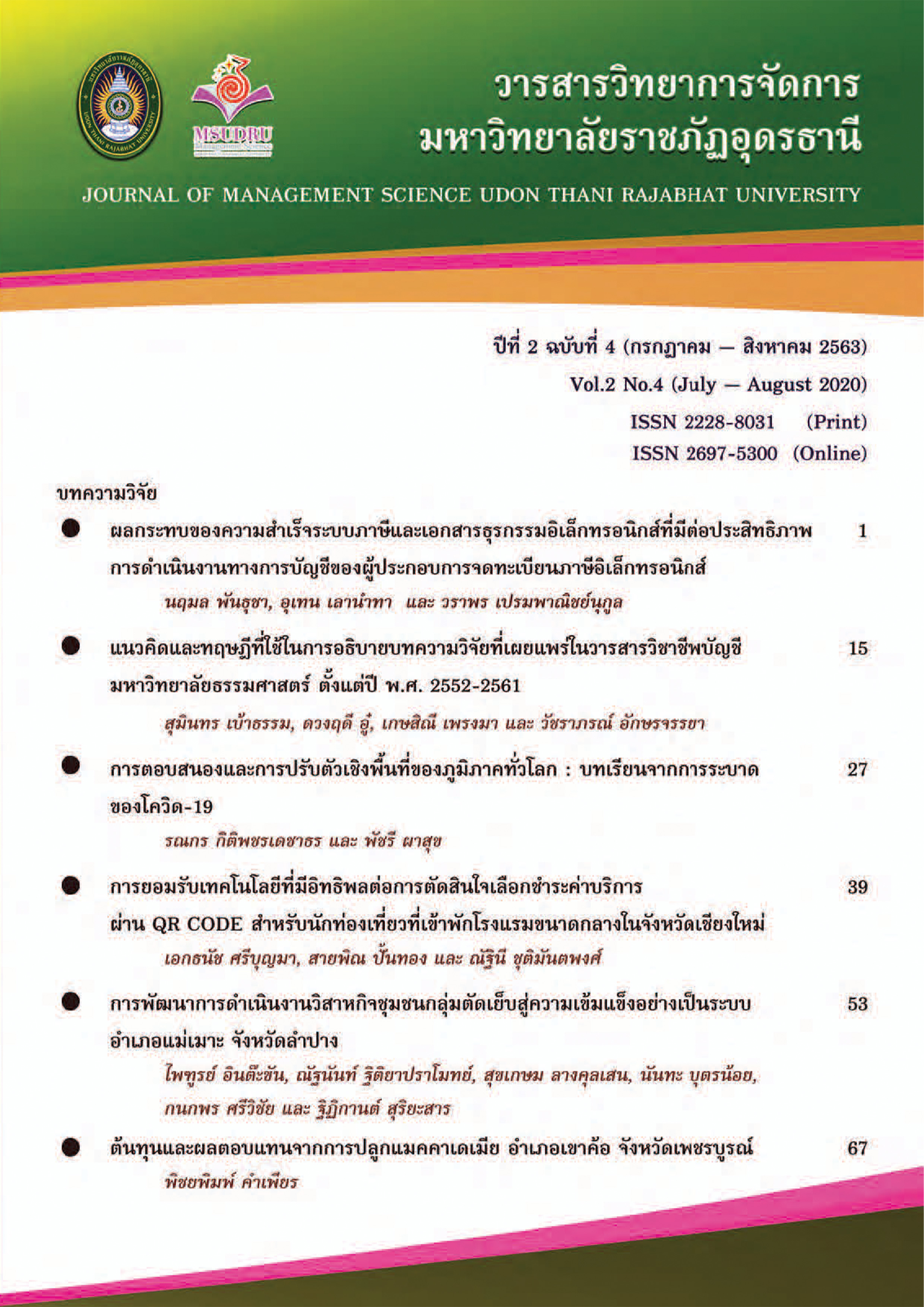การตอบสนองและการปรับตัวเชิงพื้นที่ของภูมิภาคทั่วโลก: บทเรียนจากการระบาดของโควิด-19
Main Article Content
บทคัดย่อ
การวิจัยนี้มีวัตถุประสงค์ เพื่อศึกษาถึงการตอบสนองและการปรับตัวของภูมิภาคทั่วโลกต่อการระบาดของเชื้อไวรัสโคโรนาหรือโควิด 19 ด้วยการประยุกต์ใช้แบบจำลองถดถอยโลจิสติกส์แบบลำดับขั้นในการประเมินอิทธิพลแฝงต่อการปรับตัวในการรับมือเชื้อไวรัส ณ ระดับความรุนแรงที่แตกต่างกัน ภายใต้สมมติฐานการกระจายตัวเชิงพื้นที่เหมือนกัน จากการศึกษาข้อมูลทางสถิติขององค์การอนามัยโลกที่เก็บรวบรวมจาก 185 ประเทศ ทั่วโลกในเดือนมีนาคม ถึง เมษายน พ.ศ. 2563 โดยวิเคราะห์ผลกระทบส่วนเพิ่มปรากฏว่า กลุ่มประเทศในภูมิภาค เอเชีย ยุโรป และอเมริกาเหนือ แสดงการตอบสนองและปรับตัวเพื่อรับมือเชื้อไวรัสอย่างเด่นชัด เมื่อระดับความรุนแรงของการแพร่ระบาดอยู่ในระดับ 3 ขึ้นไป โดยกลุ่มประเทศที่มีการตอบสนองและปรับตัวสูงสุดอยู่ในภูมิภาคยุโรป ในทางกลับกัน หากสถานการณ์การแพร่ระบาดของเชื้อไวรัสยังไม่มีความรุนแรง (ต่ำกว่าระดับ 3) พบว่า กลุ่มประเทศในภูมิภาคดังกล่าว ไม่ปรากฏการปรับตัวเพื่อรับมือการแพร่ระบาดอย่างมีนัยสำคัญทางสถิติ
Article Details

อนุญาตภายใต้เงื่อนไข Creative Commons Attribution-NonCommercial-NoDerivatives 4.0 International License.
บทความที่ได้รับการตีพิมพ์เป็นลิขสิทธิ์ของคณะวิทยาการจัดการ มหาวิทยาลัยราชภัฏอุดรธานี
ข้อความที่ปรากฏในบทความแต่ละเรื่องในวารสารวิชาการเล่มนี้
ไม่ใช่ความคิดเห็นและความรับผิดชอบของผู้จัดทำ บรรณาธิการ กองบรรณาธิการ และคณะวิทยาการจัดการ มหาวิทยาลัยราชภัฏอุดรธานี ความรับผิดชอบด้านเนื้อหาและการตรวจร่างบทความแต่ละเรื่องเป็นความคิดเห็นของผู้เขียนบทความแต่ละท่าน
เอกสารอ้างอิง
Akaike, H. (1973). Information theory and an extension of the maximum likelihood principle. (2nd ed.). New York: Springer-Verlag.
Areajo, M., & Naimi, B. (2020). Spread of SARS-CoV-2 Coronavirus likely to be constrained by climate. Retrieved April 16, 2020, from https://www.medrxiv.org/content/10.1101/2020.03.12.20034728v3
Bank of Thailand. (2020). Measure Foreign Fiscal Spending on COVID-19. Retrieved April 23, 2020, from https://www.bot.or.th/Thai/FinancialInstitutions/COVID19/Documents/Measure_Foreign.pdf
Berkeley, L., & Noah, H. (2020). It’s a ‘false hope’ coronavirus will disappear in the summer like the flu, WHO says. Retrieved April 16, 2020, from https://www.cnbc.com/2020/03/06/its-a-false-hope-coronavirus-will-disappear-in-the-summer-like-the-flu-who-says.html
Bliss, C. I. (1934). The Method of Probits. Science, 79(2037), 38-39.
Chen, X., & Yu, B. (2020). First two months of the 2019 Coronavirus Disease (COVID-19) epidemic in China: real-time surveillance and evaluation with a second derivative model. Global Health Research and Policy, 5(1), 2-9.
Gujarati, D. N., & Porter, D. C. (2009). Basic Econometrics. (5th ed.). New York: McGraw-Hill Education.
Jianxi, L. (2020). When Will COVID-19 End. Retrieved April 23, 2020, from https://ddi.sutd.edu.sg/
Jone, C., Philippon, T., & Venkateswaran, V. (2020). Optimal Mitigation Policies in a Pandemic: Social Distancing and Working from Home. Retrieved April 23, 2020, from https://callumjones.github.io/files/covid.pdf
Kaplan, G., Moll, B., & Violante, G. (2020). Pandemics According to HANK. Retrieved April 29, 2020, from https://benjaminmoll.com/wpcontent/uploads/2020/03/HANK_pandemic.pdf
Kermack, W. O., & McKendrick, A. G. (1927). A Contribution to the Mathematical Theory of Epidemics. Proceedings of the Royal Society of London Series A, 115(772), 700-721.
Kinross, P. et al. (2020). Rapidly increasing cumulative incidence of coronavirus disease (COVID-19) in the European Union/European Economic Area and the United Kingdom, 1 January to 15 March 2020. Eurosurveillance, 25(11), 2-6.
Krueger, D., Uhlig, H., & Xie, T. (2020). Macroeconomic Dynamics and Reallocation in an Epidemic. Retrieved April 29, 2020, from https://www.nber.org/papers/w27047.pdf
Matt, H. (2020). Scientists found regions hit hard by coronavirus share similar climate. Retrieved April 16, 2020, from https://www.inkstonenews.com/science/scientists-found-regions-hit-hard-coronavirus-share-similar-climate/article/3075085
Sajadi, M. et al. (2020). Temperature and Latitude Analysis to Predict Potential Spread and Seasonality for COVID-19. Retrieved April 16, 2020, from https://blogs.chapman.edu/wpcontent/uploads/sites/46/2020/03/Temperature-and-latitude-analysis-to-predict-potential-spread-and-seasonality-for-COVID-19.pdf
Spiteri, G. et al. (2020). First cases of coronavirus disease 2019 (COVID-19) in the WHO European Region, 24 January to 21 February 2020. Eurosurveillance, 25(9). 2-7.
Stoecklin, S. B. et al. (2020). First cases of coronavirus disease 2019 (COVID-19) in France: surveillance, investigations and control measures, January 2020. Eurosurveillance, 25(6). 20-26.
World Health Organization. (2020). COVID-19 Strategic Preparedness and Response Plan. Retrieved April 23, 2020, from https://www.who.int/publications-detail/strategic-preparedness-and-response-plan-for-the-new-coronavirus


